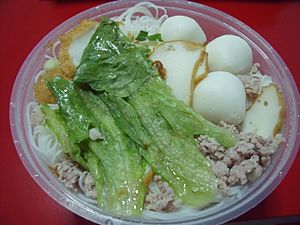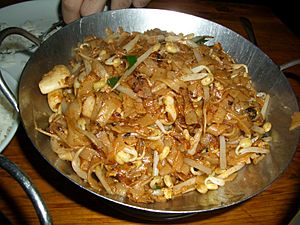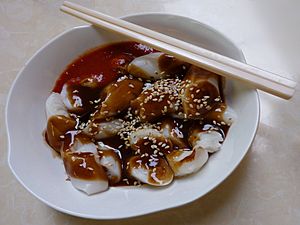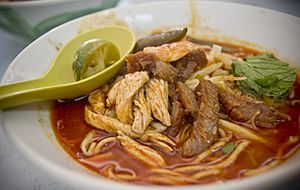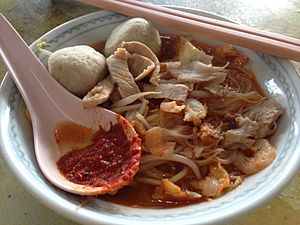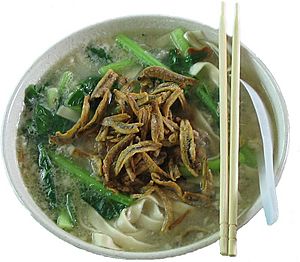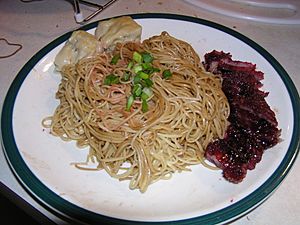Malaysian Chinese cuisine facts for kids
Malaysian Chinese cuisine is a delicious mix of food traditions. It comes from Chinese people who moved to Malaysia a long time ago. They brought their cooking styles from places like Fujian, Cantonese, Hakka, and Teochew in southern China. Over time, they mixed their old recipes with new ideas from Malaysian culture. This created unique and tasty dishes you can only find in Malaysia.
As these early immigrants settled in different parts of Malaysia, they kept their food traditions. But they also added local Malaysian flavors. For example, Hainanese chicken rice in Malaysia uses tropical pandan leaves. It also comes with a special chili sauce. This makes it taste different from chicken dishes in Hainan Island itself. Some of these foods became famous in certain towns. Now, they are popular all over Malaysia.
You can find Chinese food everywhere in Malaysia. It's common in areas with many Chinese communities. You'll see it at roadside stalls, food courts (called hawker centres), and coffee shops (kopitiam). You can also find it in fancy cafes and restaurants. Many Chinese dishes use pork. But chicken is often available for Muslim customers. Some Chinese restaurants even have a special halal certification.
Popular Malaysian Chinese Dishes
- Bakkwa (Chinese: 肉干) - This means "dried meat." Bakkwa is like barbecued meat jerky. It's very popular during Chinese New Year. But you can buy and eat this tasty snack all year round.
- Bean Sprouts Chicken (Chinese: 芽菜雞) - This is a famous dish from Ipoh. It has poached or steamed chicken. It comes with blanched bean sprouts from the local area. These sprouts are dressed simply with soy sauce and sesame oil. Ipoh's bean sprouts are extra crunchy. This is because of the special mineral-rich water there. This dish is usually served with hor fun noodles in chicken broth. Or you can have it with plain rice.
- Beaufort Mee (Chinese: 保佛炒麵) - This is a special noodle dish from Beaufort town. Handmade noodles are smoked first. Then they are stir-fried in a wok. They are mixed with meat (like char siu pork) or seafood. Lots of green vegetables, like choy sum, are added. Finally, a thick, rich gravy is poured over it.
- Cantonese fried noodles (Chinese: 廣府炒麵) - This dish has noodles that are fried until they are crispy. They form a base for a thick white sauce. This sauce is made with egg and cornstarch. It has sliced pork, seafood, and green vegetables like choy sum. A similar dish is wa tan hor (Chinese: 滑旦河). It uses hor fun noodles, but they are not deep-fried, just charred. Another version is yuen yong (Chinese: 鴛鴦). It mixes crispy fried rice vermicelli and hor fun noodles under the sauce.
- Chai tow kway (Chinese: 菜頭粿) - This is a common dish in Malaysia. It's made from rice flour. It's also called fried radish cake. But it usually doesn't have radish in the rice cakes. Sometimes, preserved radish is added when cooking. The seasonings and extra ingredients change by region. They might include bean sprouts and eggs.
- Chee cheong fun (Chinese: 豬腸粉) - These are square rice sheets. They are made from a thick mix of rice flour and water. This liquid is steamed on a special pan. The steamed sheets are then rolled or folded. It's often served with tofu stuffed with fish paste. You eat it with a semi-sweet fermented bean paste sauce, chili paste, or light vegetable curry gravy. Ipoh and Penang have different versions. In Ipoh, some stalls serve it with a red sweet sauce, pickled green chilies, and fried shallots. In Penang, a sweet, black shrimp sauce called hae ko is the main topping.
- Chun gen (Chinese : 春卷) - This is an oblong roll. It has seasoned ground pork or beef. This is wrapped in a thin omelette and steamed. The name comes from the Hakka word for spring, "chun." It's said to have been around since ancient times in China. Today, you can find it in Chinese communities across Sabah. You can eat it plain, in broth, or stir-fried with noodles or vegetables.
- Curry Mee (Chinese : 咖喱麵) - This is a bowl of thin yellow noodles mixed with bihun (rice vermicelli). It's in a spicy curry soup made rich with coconut milk. It's topped with tofu puffs, prawns, cuttlefish, chicken, long beans, cockles, and mint leaves. Sambal (chili paste) is served on the side. It's often called curry laksa.
- Fish ball (Chinese: 魚丸、鱼蛋、魚圓) - These are balls made from fish paste. Fish balls are usually served with rice vermicelli or yellow noodles in a clear soup. Bean sprouts and spring onions are often added. It's usually served with a small plate of chili padi soaked in soy sauce. Fishcake is also a common addition.
- Fuzhou cuisine - You can find this food in the Sitiawan, Perak area. It's also in cities and towns in Sarawak where Hookchiu people settled. Famous dishes include ang zhao mee sua (Chinese : 红槽面线) and kompyang or kompia (Chinese : 光餅).
- Hakka mee (Chinese : 客家麵) - This is a simple noodle dish. It's topped with a gravy made from ground meat. It's a popular street food with Hakka roots. It comes from an older recipe called Dabumian (Chinese : 大埔麵). This name shows its origin from Dabu County, a center of Hakka culture in China.
- Heong Peng (Chinese : 香餅) - These fragrant pastries are a famous specialty from Ipoh. They look like slightly flattened balls. They have a sweet, sticky filling made from malt and shallots. This is covered by a flaky baked crust. Sesame seeds are sprinkled on top.
- Hokkien Mee (Chinese: 福建炒麵) - There are two main types of Hokkien Mee in Malaysia.
- Penang Hokkien mee is also called hae mee (Chinese : 蝦麵) in other parts of Malaysia. It's one of Penang's most famous dishes. It's a noodle soup with yellow and rice noodles. They are in a spicy broth made from prawns and pork (or chicken for halal versions). It's topped with a boiled egg, poached prawns, chopped kangkung, and a dollop of sambal.
- Hokkien char mee is a dish of thick yellow noodles. They are braised and fried with thick black soy sauce. Crispy lardons are added. This version is more common in the Klang Valley. It was first created in Kuala Lumpur. So, in central Malaysia, "Hokkien mee" usually means this fried version.
- Ipoh white coffee (Chinese : 怡保白咖啡) - This popular coffee drink started in Ipoh. Regular Malaysian black coffee ("Kopi-O") uses a dark roast. But "white" coffee is roasted lighter, only with palm oil margarine, no sugar or wheat. This makes it much lighter. It's usually made richer with condensed milk before serving.
- Kam Heong (Chinese : 金香) - This means "golden fragrance." Kam Heong is a cooking method from Malaysia. It's a great example of how different cultures mix in Malaysian food. It uses bird's eye chilies, curry leaves, dried shrimp, curry powder, oyster sauce, and other seasonings. This creates a versatile stir-fry sauce. It tastes great with chicken, clams, crabs, prawns, and squid.
- Kolo mee or mee kolok (Chinese : 乾撈麵) - This dish has springy egg noodles. They are tossed in a sweet and savory dressing made from shallots, lard, and vinegar. It's topped with seasoned minced pork and char siu. It's similar to Hakka mee or wonton mee, but tastes quite different. A popular version uses oil from cooking char siu to flavor the noodles. This gives them a reddish color. Halal versions use beef (called mee sapi) or chicken instead of pork. Peanut or vegetable oil replaces lard. You can also add mushrooms, chicken, and crab meat. Kampua mee (Chinese: 乾盤面) is a similar dish from Sibu and Sitiawan with Fuzhou origins.
- Kuching Laksa or Laksa Sarawak (Chinese : 古晉叻沙) - This dish has noodles (usually rice vermicelli). They are served in a fragrant, spiced coconut milk soup. It's topped with shredded chicken, shredded omelette, bean sprouts, and prawns. It's garnished with coriander. This famous Sarawak dish looks like curry laksa. But the Sarawak version is more subtle and flavorful. It's made with a laksa paste that includes sambal belacan, tamarind, lemongrass, herbs, and spices. A little coconut milk is added. This gives it a good balance of herbs and spices with a hint of sour and spicy notes. The broth is creamy but not too rich.
- Kway chap (Chinese : 粿汁) - This is a Teochew dish. It has rice noodle sheets in a dark soy sauce gravy. It's served with pork pieces, pig offal, tofu products, and boiled eggs.
- Lor Bak (Chinese : 滷肉) - This is a fried meat roll. It's made from spiced minced pork and chopped water chestnuts. This mixture is rolled in soya bean curd sheets and deep-fried. It's usually served with a small bowl of Lor (a thick broth) and chili sauce. The term also includes other items sold with the meat rolls. These can be tao kwa (hard tofu), pork sausages, and tofu skin sheets.
- Lor Mee (Chinese : 滷麵) - This is a bowl of thick yellow noodles. They are served in a thick gravy. This gravy is made from eggs, starch, and pork stock.
- Marmite chicken (Chinese : 媽蜜雞) - This is a unique dish. It has marinated fried chicken pieces. They are covered in a syrupy sauce. This sauce is made from marmite, soy sauce, maltose, and honey. This dish can also be made with other ingredients like pork ribs and prawns.
- Mee Hailam (Chinese : 海南麵) - These are stir-fried egg noodles. They come with meat or seafood and lots of vegetables. They are covered in a gravy seasoned with dark soy sauce and calamansi lime. It's a common dish in Hainanese restaurants.
- Ngah Po Fan or Sha Po Fan (Chinese : 瓦煲飯 or 沙煲飯) - This is seasoned rice. It's cooked in a claypot with other ingredients. It's finished with soy sauce. A common example is rice cooked with chicken, salted fish, Chinese sausage, and vegetables. Claypots are also used for braising noodles, meat dishes, and making soups thicker.
- Ngiu chap (牛什) - This is a Chinese-influenced dish. It's beef broth served with noodles. The noodles are usually in the soup. It comes with poached beef slices, meatballs, stewed brisket, tendon, liver, and other offal parts. It's a famous Sabahan dish. Ngiu chap has many different versions. There's a lighter Hainanese style and heartier Hakka-influenced flavors. There are even village-style ngiu chap adapted for local Sabahan tastes.
- Oyster omelette or O-chian (Chinese: 蚝煎) - Small oysters are stir-fried on a hot plate. Then they are mixed into an egg batter. Moistened starch is added to thicken it. Finally, it's fried until crispy. Unlike other oyster omelettes, Malaysian versions don't have a thick savory gravy poured over them. A chili sauce is given on the side for dipping.
- Pan mee (Chinese: 板面) - This is a noodle soup. It has hand-kneaded and torn pieces of noodles. Or it can have regular strips of machine-pressed noodles. They have a chewy texture, like Italian pasta. A popular version in the Klang Valley is "Chilli Pan Mee." It has cooked noodles served with minced pork, a poached egg, fried anchovies, and fried chili flakes. You add the chili flakes to your taste. Chilli Pan Mee comes with a bowl of clear soup with leafy vegetables.
- Popiah (Chinese: 薄餅) - This is a Hokkien/Teochew-style crepe. It's stuffed and rolled with cooked shredded tofu and vegetables like turnip and carrots. The Peranakan version has shredded bangkuang (jicama) and bamboo shoots. The filling is seasoned with tauchu (fermented soybean paste) and meat stock. Another version has popiah covered in a spicy sauce. Popiah can also be deep-fried. Then it's served like a Chinese spring roll.
- Sang nyuk mian (Chinese: 生肉麵) - This dish has noodles served with pork broth. It started in Tawau. It's very popular with non-Muslim communities in Sabah. It's named after the tender, marinated pork slices. These are poached when you order them. They are served in pork broth flavored with fried lard bits. The noodles (usually thick yellow noodles) are either dressed in dark soy and lard. Or they are put into the soup with the pork slices, vegetables, meatballs, and offal.
- Seremban Siew Pau (Chinese: 芙蓉燒包) - The town of Seremban is famous for its siew pau. This is a flaky, oven-baked pastry bun. It has a sweet BBQ pork and green pea filling. Chicken fillings are available as a halal option.
- Teochew porridge - Teochew porridge or muay (Chinese: 糜) is a type of rice porridge or soup. Unlike congee, Teochew porridge is thin and watery. You can see the rice grains at the bottom of the bowl. It's eaten as a substitute for plain cooked rice, not as a full meal by itself. It's served with many side dishes. These can be vegetables, meat, and salted egg. At restaurants specializing in Teochew porridge, you can find a buffet of at least a dozen different dishes. Some recipes add sweet potatoes or even shark meat to the porridge while cooking.
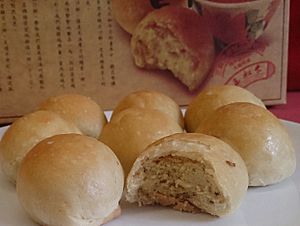
- Tau sar pneah (Chinese: 豆沙餅) - This is a famous Penang delicacy. This round Chinese pastry is made of wheat flour, sugar, green bean paste, fried onions, lard, and salt. It's also called Tambun biscuits. People believe it was invented in Bukit Tambun, Penang. It's so popular that it's one of the must-buy souvenirs from Penang.
- Tomato kway teow (Chinese: 茄汁粿條) - This dish has kway teow noodles stir-fried with a sweet tomato gravy. It also has meat (usually chicken pieces), eggs, and vegetables. It's a popular dish in Chinese restaurants throughout Sarawak. Another version (Chinese: 茄汁麵) uses egg noodles that are fried until crispy. Then they are covered with the gravy and ingredients.
- Tuaran mee (Chinese: 斗亞蘭面) - This is a specialty of Tuaran town. This dish of wok-fried fresh handmade noodles is well known in nearby Kota Kinabalu. It's also popular in Tamparuli town, where it's called Tamparuli mee (Chinese: 担波羅利炒生面). The noodles are first toasted with oil in the wok. This stops them from sticking together. Then they are blanched to make them less crunchy. The last step is stir-frying the noodles until dry. Eggs, vegetables, and meat or seafood are added.
- Wonton Mee (Chinese: 雲吞麵) - This dish has thin egg noodles with wonton dumplings (Chinese: 雲吞), choy sum, and char siu. The dumplings are usually made of pork or prawns. They are typically boiled or deep-fried. The noodles can be served in a bowl of broth with dumplings, like in the traditional Cantonese way. But in Malaysia, it's more commonly dressed with a dark soy sauce. Boiled or deep-fried wonton dumplings are either a topping or served on the side in a bowl of broth. Variations of this dish often change the meat. These can include roast pork (烧肉), braised chicken feet, and roast duck (燒鴨).
- Yam rice (Chinese: 芋頭飯) - This is a savory rice dish. It's cooked with taro, Chinese sausage, chicken, dried prawns, and mushrooms. It's often served with dishes like bak kut teh or yong tau foo.
- Yusheng (Chinese: 魚生) - This is a festive raw fish salad. It's also called yee sang. While raw fish dishes existed in ancient China, yusheng was created in Singapore in 1964. It has strips of raw fish tossed at the dining table. Shredded vegetables, crispy bits, and a mix of sauces are added. Yusheng means "raw fish." But the word for "fish" sounds like "abundance." So, yusheng is seen as a symbol of good fortune and growth. Because of this, mixing and tossing yusheng with chopsticks has become a special part of Chinese New Year celebrations in Malaysia and Singapore.
- Zongzi (Chinese: 粽子) - This is a traditional Chinese food. It's made of glutinous rice stuffed with savory or sweet fillings. It's wrapped in bamboo, reed, or other large flat leaves. They are cooked by steaming or boiling. They are a special part of the Duanwu festival. This festival is still celebrated by Chinese communities in Southeast Asia.
Sweet Treats and Desserts
- Leng Chee Kang - This is a mix of cooked ingredients in a sweet soup. The ingredients can vary a lot. But lotus seed is always the main one. The soup might also have dried longan, white fungus, barley, kembang semangkuk jelly, and rock sugar. Leng Chee Kang can be served warm or cold.
- Mooncake (Chinese : 月饼) - These are round or rectangular pastries. They have a rich, thick filling. They are traditionally eaten during the Mid-Autumn Festival with Chinese tea. Both the traditional baked mooncake and the snow skin version are popular in Malaysia during the festival season.
- Muar Chee (Chinese : 麻糍) - These are sticky glutinous rice ball lumps. They are coated in a sweet mix of crushed peanuts and sesame seeds. They are served with toothpicks.
- Tangyuan (Chinese : 汤圆 or 湯圓) - These are plain white or colored sweet dumplings. They are made from glutinous rice flour. Traditionally, they are homemade and eaten during Yuanxiao and the Dongzhi Festival. But now, tangyuan is sold as a dessert all year round. Tangyuan dumplings with filling are usually served in a lightly sweetened clear syrup. Unfilled ones are served as part of a sweet dessert soup.
- Tau foo fah or Dau Huay (Chinese : 豆腐花 or 豆花) - This is a very soft, velvety pudding made from silken tofu. It's traditionally flavored with a brown sugar syrup.
- UFO tart (Chinese : 牛屎堆) - This tart has a flat, thin base of baked mini butter sponge cake. It's topped with a creamy egg custard. This is then crowned with a meringue slurry. Its Chinese name literally means "cow pile dung." This refers to the piped shape of the toppings and the darker color of the meringue from caramelization. A Hainanese bakery in Sandakan made these popular in the 1950s. Their popularity has spread to Kota Kinabalu and other towns in Sabah.
Images for kids
-
Chai tow kway stir-fried dark (with dark soy and molasses) or light (salt and fish sauce)


